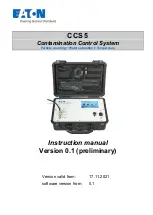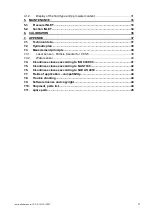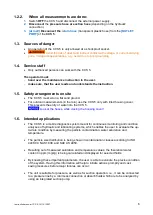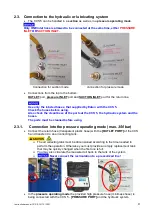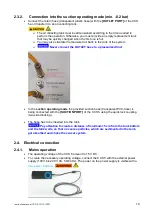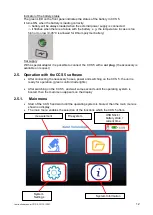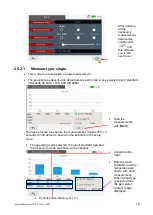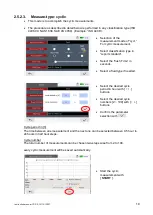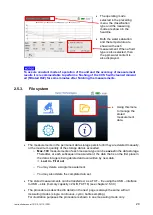
Instruction manual CCS 5, 15/ 10/ 2021
6
1.2.2.
When all measurements are done:
1.
Switch
OFF
the CCS 5 and disconnect the external power supply.
2.
Disconnect
the
pressure hose or suction hose
(depending on the hydraulic
connection).
3.
(at last!)
Disconnect the
return hose
(transparent plastic hose) from the
[OUTLET
PORT]
of the
CCS 5
.
1.3. Sources of danger
•
An operation of the CCS 5 is only allowed at a shockproof socket.
•
Avoid the risk of direct and indirect contact with voltage- or current-carrying
parts. Voltage disappearances, e.g.: avoid due to poor grounding.
1.4. Service staff
•
Only authorized persons can work with the CCS 5.
The operator must:
-
hand over the maintenance instruction to the user.
-
make sure, that the user reads and understands the instruction.
1.5. Safety arrangements on site
•
The CCS 5 must sit on a flat solid ground.
•
For outdoor measurements (in the rain) use the CCS 5 only with tilted housing cover.
This prevents the entry of water into the CCS 5.
Look at the hoses, while closing the housing cover!
1.6. Intended applications
•
The CCS 5 is a mobile diagnostic system meant for continuous monitoring and condition
analyses of hydraulic and lubricating systems, which enables the user to evaluate the up-
to-date condition by measuring the particle contamination, water saturation and
temperature.
•
The particle size distribution is being shown in contamination classes according to ISO
4406:99, NAS 1638, and SAE AS 4059.
•
Resulting out of measured saturation and temperature values, the theoretical water
content in ppm (mg/kg) is being calculated and displayed for selected fluids.
•
By knowing these important parameters, the user is able to evaluate the precise condition
of the system. Having this information will help to initiate actions promptly and cost-
saving measures before major failures can occur.
•
The unit is suitable for pressure, as well as for suction operation, i.e., it can be connected
to a pressure line by a minimess connection or absorb fluids which are to be analyzed by
using an integrated suction pump.

